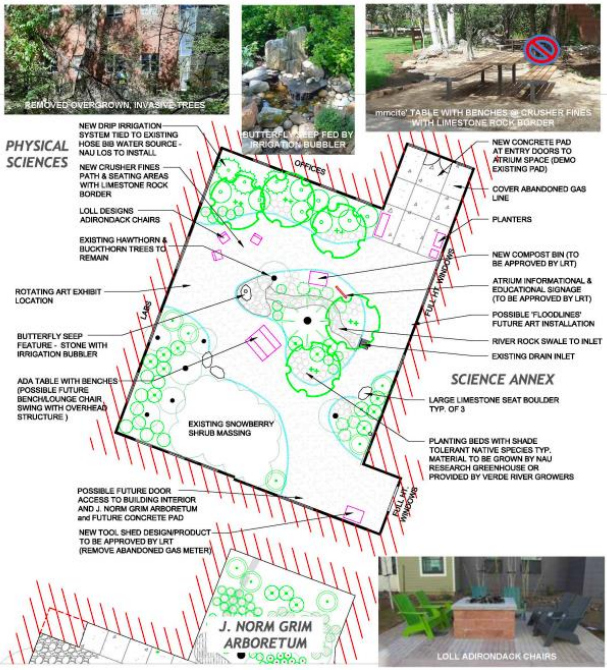If you’re a student, you may have noticed a $15 green fee on your tuition invoice. But have you ever wondered exactly where that money goes?
Every green fee gets pooled together in a pot of money called the Green Fund that is used to support sustainability initiatives around the Flagstaff mountain campus. All those fees give the Green Fund an annual budget of around $600,000 to help make campus a greener place.
Since its founding in March 2010, the Green Fund has invested more than $3 million in more than 110 projects around campus, including the Yellow Bike Program, the San Francisco Parking Garage solar array and the Secret Garden.
Who decides where the money goes?

For third year student Lindsay Mauss, the opportunity to work as the Green Fund’s public relations specialist was a perfect blend of her passions and her skills.
“I’ve always felt passionate about sustainability, and I was lucky to find a spot in the sustainability world where I was welcome as a communications major.”
Mauss said that she has learned how to engage with people on a topic that can produce a lot of dread or negative reactions through her work at the Green Fund.
“So many people already feel so pessimistic about climate change,” she said “I learned that forming relationships with people and engaging with them in a positive way helps instill a feeling of confidence and power in them.”
It’s exactly that engagement with the campus community that makes the Green Fund work. All the projects the committee supports are brought to them by university students, faculty or staff members.
How do I get involved with the Green Fund?
Fourth year student Grace Carr, the committee’s impact analyst, said she was drawn to the Green Fund for its ability to amplify student voices and acknowledge the positive influence they can have on the community by funding their sustainability projects and research.
“By lowering the barriers to getting involved in green efforts on campus, we can help give students, staff and faculty the opportunity to reclaim their power in the face of a mounting environmental dilemma,” Carr said.
Students who wish to see their ideas implemented do not need to work for the Green Fund. Any member of the NAU community—including faculty and staff—can submit their project idea to the Green Fund for consideration.
For Mauss, that’s the most important thing.
“All students can submit proposals and utilize the fee that they’re paying every semester. It doesn’t matter if they study sustainability or not—everyone can get involved.”
The process of submitting to the Green Fund begins with an idea summary—a brief initial pitch that allows the committee to do a quick check to see if the idea is something they are in a position to fund before the applicant develops a full proposal. If the idea meets the necessary basic criteria and the committee believes it has potential, the Green Fund will assign one of its members to work with the applicant on proposal development with the ultimate goal of designing a project that is ready to fund.
What should I submit?
Projects must fall under one of the seven CAP categories—energy, water use, transportation, waste minimization, landscape management, resilience and environmental justice—and must be in line with the Green Fund’s mission to reduce NAU’s negative impact on the environment and create a culture of sustainability.

Carr also said she would love to see different kinds of engagement with sustainability across disciplines.
“There are so many bright, open-minded students in the social sciences and beyond who might feel excluded from the sustainability space because of its perceived technical nature. I want to encourage anyone affiliated with NAU to consider how they can apply their unique skills, especially those in the arts and humanities, to furthering green causes on campus. It takes more than just the STEM side of things to make change in our community.”
The Green Fund takes care to support projects across the spectrum, funding both technological solutions—such as water bottle fill stations, electric vehicles and waste receptacle sensors—and educational and community building events and initiatives. The Green Fund also provides grants for student research that investigates NAU’s environmental impact.
Thoughtful collaboration and deliberation
The whole process is thorough, deliberate and collaborative. Through group discussions of a project’s merits and potential pitfalls, extended partnerships with applicants and relationship maintenance with departments across campus, the committee demonstrates its commitment to not only providing the financial backing for sustainable initiatives, but also to encouraging continued engagement with sustainability among NAU’s community members.
Linthicum said he puts his trust in the students’ decisions and encourages his colleagues to do the same.
“Trust your students to be thoughtful and capable managers of these funds. The student committee asks really challenging questions and they are immensely responsible stewards.”
Jessica Clark | NAU Communications
jessica.clark@nau.edu




